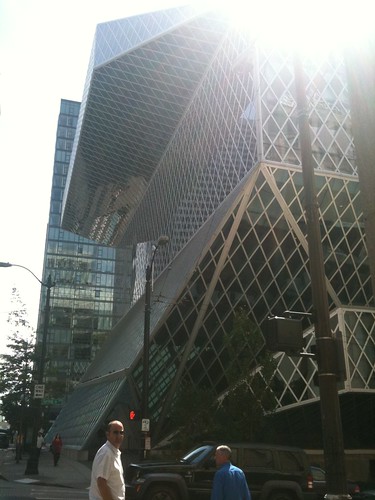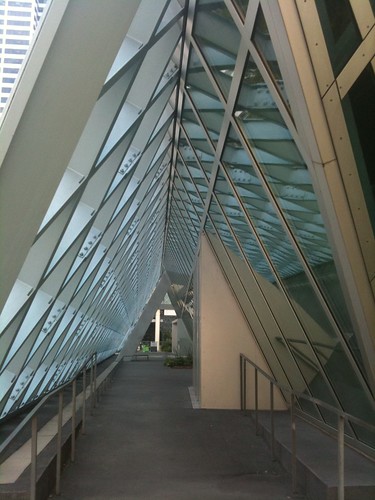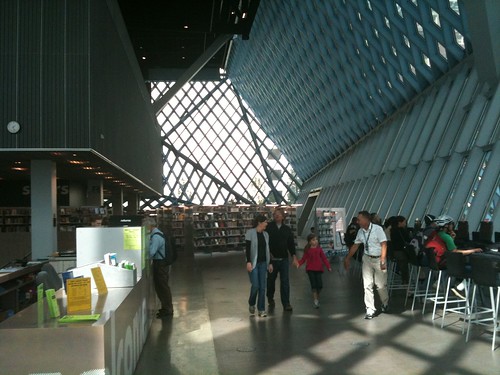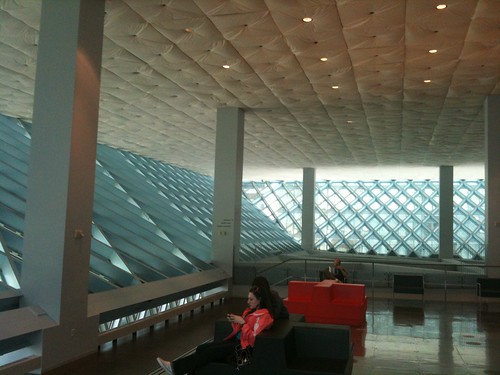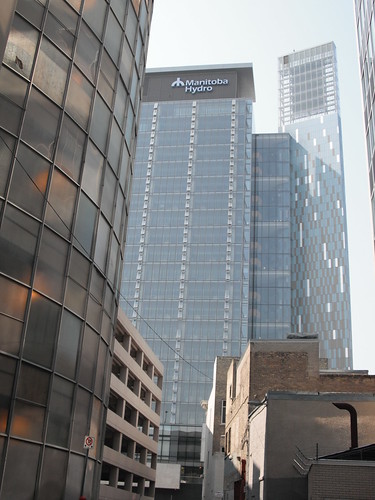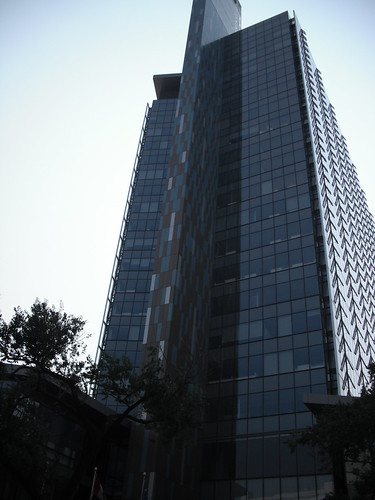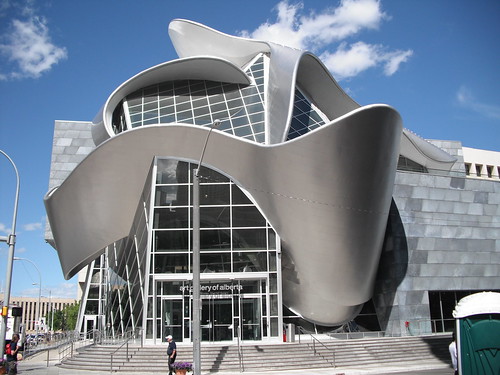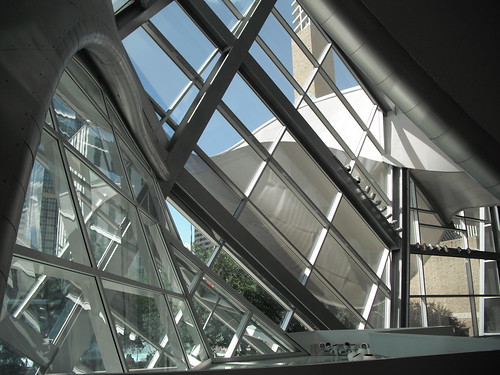For my latest artwork, I've been piecing together a collection of drawings titled "dreaming the city". I'm particularly interested in expressing cognitive perspectives of urban experience; the ways we engage with spaces both built and natural. I'll be updating this as more pieces become finished.
Urban Locality
"Raum ist der Ausdruck der Gesellschaft." - Manuel Castells
Sunday, August 14, 2011
Tuesday, July 26, 2011
Saturday, May 28, 2011
Cognitive Mapping and Urban Planning
My Recent article, Representing Social Space: Cognitive Mapping and the Potential for Progressive Urban Planning & Design has been published by the UBC Trail 6 Journal of Geography. Ofcourse, I had to have a little fun and make this video...
Tuesday, December 7, 2010
Can we build communities with new urbanism?
Sprawl, an outgrowth of the post-war suburban landscape, has become a highly contentious issue in contemporary North American cities. The amorphous expanses of single-family housing units have been blamed to cause many of the 21st century's environmental problems, but have also been highly criticized in social geography as well. Seen as a fault of modernist planning, post-war suburbs have been criticized for causing a dehumanized rationalization of landscape in which technical procedures such as rigid zoning and car-centric growth mechanisms ignore human sensibilities and freedoms (Ralph 1981). In compartmentalizing landscapes through positivist planning methods, post-war suburbs have been seen to impede human contact and promote social polarization and gated communities. In considering the social crises that has ensued, much thought has been given in contemporary urban planning and design toward retrofitting suburbs in such a way as to restore the sense of social cohesion and 'place' that are seen to be indicative of a pre-war epoch. New Urbanism, a movement which promulgates the central tenets of mixed-use, high-density, and human scaled design, is one of the most prominent of such retrofitting strategies. In combining such features with neo-traditional architectures, which are seen appeal to a 'sense of community' from the past, New Urbanism aims to retain the social cohesion and 'place' which has become undermined by current suburban landscapes. Considering that two suburban regions in the Lower Mainland, the East Vancouver Fraser Lands and the Southlands of Tsawwassen, are being considered for New Urbanist development, this essay will draw upon critical socio-spatial theory to evaluate the potential for New Urbanism as a mechanism towards creating 'place' – the social integration of community space. By analyzing the pros and cons, I argue that New Urbanism has the ability to fulfill its social potential in suburban retrofitting so long as it draws upon community involvement and a diverse social fabric, as is indicative of Hope VI and 'Vancouverism.'
A central component to the New Urbanism movement is the use of neo-traditional architecture and urban design as a means to restore the 'community' of the 1920s. Neotraditionalists such as Andres Duany, co-founder of the Congress for New Urbanism, argue that restoring the mixed-land uses of pre WWII urbanism is essential for reintegrating the community which has been lost by the segregation of land-uses in today's planning (Newsweek 1995). Duany argues that traditional architectures "manifest human activity," and explains this further in his interview with The Tyee:
you look up and see a studio window, and you say: 'Shit, that must be cool up there.' Or you look at a house that has a porch and, even if the porch is not inhabited, you can project yourself into what it would be like: 'Oh, I could be sitting there with my buddies or having a party or drinking beer, or my child could be playing.' Traditional architecture expresses how humans inhabit it. It communicates to those who are untrained in architecture. (2007)
In emphasizing the use of traditional architectural designs such as Victorian gingerbread or Cape Code, New Urbanism aims to use design, the creative engagement with physical form, to increase the likelihood of human interaction, and thereby promote the restoration of 'community.' This emphasis on physical design as a means to understanding social interaction is logical to the extent that one attributes today's social polarizations to the segregated land-uses of the post-war suburb. Indeed, from this standpoint, physical design has the potential to produce 'placelessness,' but can also restore it, and thereby act as the solution toward building 'community.' Looking toward physical form as the pre-eminent force behind shaping social relations has, however, faced much criticism. The prominent social geographer David Harvey gives much consideration toward the dangers of New Urbanist spatial determinism.
In The New Urbanism and the Communitarian Trap, Harvey argues that in perpetuating "the idea that the shaping of spatial order is or can be the foundation for a new moral and aesthetic order…the movement does not recognize that the fundamental difficulty with modernism was its persistent habit of privileging spatial forms over social processes" (1997: 2). By emphasizing social process over spatial form, Harvey undermines the New Urbanist notion that community can be constructed through design. This de-legitimization of New Urbanist approaches towards community is highlighted as it poses no difference to that of the modernist approach which has produced the suburbs that New Urbanism is now trying to retrofit. Ultimately, this can be seen as an attempt to fix broken communities with the same tools that enabled them to be broken in the first place. This notion has, furthermore, led to the argument that New Urbanist spatial determinism merely calls for a different type of suburbia, rather than seriously overcoming metropolitan social segregation (Fainstein 1996: 183). It is the creation of this different type of suburbia that has led to the understanding that New Urbanist spaces create a false sense of 'community' through socio-economic exclusion. Therefore, a problem of many New Urbanist projects, in regards to creating genuine social cohesion, is that they must
rely on private developers to build and finance their visions; consequently, they are producing only slightly less exclusive suburbs than the ones they dislike. Although their creations will contain greater physical diversity than their predecessors, their social composition will not differ markedly. (Fainstein 1996: 184)
One of the most prominent New Urbanist developments, Celebration in Florida, is emblematic of such criticism. Celebration, a master-planned community designed by the Disney Corporation, is more economically and racially homogenous than the United States demographic average. According to the U.S. Census Bureau (Profile of Selected Economic Characteristics: 2000), the highest percent of household income earnings in Celebration are in the $50,000 to $74,999 range with 22.9% of the population. Following this is the range of $100,000 to $149,999 for 14.8%, and thirdly 14.7% with $75,000 to $99,999. These incomes, which make up over half of the community, are much higher than the American household income average which is $41,994 (Celebration CDP Florida Fact Sheet - U.S. Census Bureau). In regards to the racial makeup, Celebration is 93.6% white compared to the U.S. average which is 75.1%, 1.7% black compared to the U.S. average of 12.3%, and 2.4% Asian compared to the national average of 3.6%. In using neo-traditionalist architectures as the central mechanism to building community, critics have attributed this New Urbanist approach to a "nostalgic fantasy" which can only be conjured up in modern times by "a community of like-minded people within a narrow socioeconomic band" (Beardsley Feb. 1997: 92). This has led to the notion that New Urbanism is now creating a situation in which the rich are choosing 'the image of community' as opposed to real community (Skully 1994). In considering how capital is defining the meaning of 'community,' David Harvey looks to the ways in which the creation of community is an exclusionary process. He presents this as the "dark side of communitarianism," which is how
the 'spirit of community' has been held as an antidote to any threat of social disorder, class war, and revolutionary violence. "Community" has ever been one of the key sites of social control and surveillance, bordering on overt social repression. Well-founded communities often exclude, define themselves against others, erect all sorts of keep-out signs. (Harvey 1997: 3)
It is from this standpoint that "community has often been a barrier to rather than facilitator of progressive social change" (Harvey 1997: 3). Defining the ability of New Urbanism to produce a genuine community entirely on the homogeneity of its most privatized projects, however, does not do the movement full justice. In his interview with The Tyee (2007), Andres Duany explains how New Urbanists have done much in the realm of producing community through social-economic equality and diversity:
we wrote the standards for Hope VI, which is the American housing scheme, which is responsible for between 180,000 and 280,000 [units of] affordable housing, all subsidized, many of them designed by charter members of the new urbanism… Actually, we've been responsible for almost all the affordable housing designed in the United States in the last 10 years, since the Hope VI project.
Although Hope VI uses New Urbanism as a means to engage in defensive space, a spatially deterministic theory which looks to how design influences behaviour (Newman 1972), it does address the need to fix public housing and increase community diversity. Mixed income development through mixed finance public housing is central to renewing segregated areas of blight into revitalized areas of well integrated social fabrics. This approach to New Urbanism draws upon partnerships with local governments, non-profits, and private businesses ("About Hope VI" – HUD).
Another example of how government-influenced New Urbanism has been successful in building socially integrated communities is the "Vancouver Model," also known as "Vancouverism." In analyzing the success of Downtown Vancouver's revitalization, Leonie Sandercock looks to how the Urban Design Advisory Panel facilitated a more open and participatory process (2006: 52). Examples of this include how neighbouring communities, property owners, special interest groups, and the general public have been consulted in waterfront projects (2006: 55). Sandercock attributes this integration of the social fabric as a central component in urban design regulations. These regulations have led to the successful integration of Concord Pacific developments which must have 20% of residential units as social, and another 25% suitable for families (Sandercock 2006: 56). Ultimately, this is viewed as a triumph of civic over private ambition which has led to "high rise living with a human face" (Sandercock 2006: 56). Therefore, this tower-townhouse prototype (the "Vancouver Model"), is a Modernist form that provides the mixed-use vibrancy sought by anti-Modernists such as Jane Jacobs (Sandercock 2006: 58).
In considering how both Hope VI and the "Vancouver Model" have integrated the social fabric in the design process, it is evident that New Urbanist principles, mixed with public, private, and non-profit interests, have the ability to produce socially integrated communities. Surely the "utopianism of spatial form," which Harvey attributes to the fake and exclusive communitarianism of New Urbanism (Harvey 1997: 3), is also being counter-balanced by the "utopianism of process," which looks to integrating social processes in community building. Currently, the Southlands of Tsawwassen are being proposed for development by Century Group, and the developers for the East Fraserlands are Parklane and Wesgroup. This essay does not intend to disregard the importance of private real estate development; indeed it is central to have cooperation of the private sector in order to invest and finance progressive New Urbanist designs. However, in analyzing how the monopoly of capitalist interests to New Urbanist approaches in Celebration have led to homogenization and a false sense of community, this essay has shown how overemphasis on spatial form cannot build genuine communities. So long as Century Group, Parklane, and Wesgroup work with multiple partners, such as the local community and government, to ensure that the design reflects social progress as much as environmental and economic progress, New Urbanism could likely play a role in retrofitting suburban landscapes into a 'community' of the truest sense.
Works Cited
"About HOPE VI - Public and Indian Housing - HUD ." Homes & Communities. N.p., n.d. Web.
2 Dec. 2010. <http://www.hud.gov/offices/pih
"Andres Duany, Riverfront Gambler." The Tyee [Vancouver] 16 Jan. 2007
Beardsley, John Feb. 1997: "A Mickey Mouse Utopia", in Landscape Architecture Magazine,
Vol. 87, pp. 76-93;: American Society of Landscape Architects, Wash. DC.
"Celebration CDP, Florida - DP-3. Profile of Selected Economic
Characteristics: 2000."American FactFinder. N.p., n.d. Web. 2 Dec. 2010. <http://factfinder.census.gov/servlet/QTTable?_bm=y&-geo_id=16000US1211285&-qr_name=DEC_2000_SF3_U_DP3&-ds_name=DEC_2000_SF3_U&-_lang=en&-_sse=on>.
"Celebration CDP, Florida - Fact Sheet - American FactFinder." American FactFinder. N.p., n.d.
Web. 2 Dec. 2010. <http://factfinder.census.gov/servlet/SAFFFacts?_event=Search&geo_id=&_geoCo
Fainstein, Susan 1996: "New Directions in Planning Theory."Readings in Planning Theory.
Malden, MA: Blackwell. 173-195.
Harvey, David 1997: "The New Urbanism and the Communitarian Trap." Harvard Design
Magazine Winter/Spring: 1-3.
Newman, Oscar 1972: Defensible space; crime prevention through urban design . New York:
Macmillan.
Relph, E. C 1981: Rational landscapes and humanistic geography. London: Croom Helm.
Sandercock, Leonie 2006: "An Anatomy of Civic Ambition in Vancouver ." Urban planning
today: a Harvard design magazine reader. Minneapolis: University of Minnesota Press, 48-62.
architecture of community. Portland, Oregon: Print Vision, 221-230.
Saturday, November 27, 2010
Saturday, October 2, 2010
Urban Homestead
Quoting Manuel Castells: "Raum ist der Ausdruck der Gesellschaft" (Space is the expression of society). And isn't it true; our mainstream socialization is indeed manifested in our built environment - the social construction of space is evident in "living the dream" through the classic suburban home. In order to re-structure urban space in a sustainable manner, we must restructure our values. I came across this really cool infill residential development in Toronto which takes into account this de-comodification of the "home" as a step toward urban sustainability. Based on the idea of the Urban Homestead, this house is powered by passive systems and constructed with recyclable material. The green roof has a cooling effect, retains water to prevent wasteful runoff, and the soil and plant combination provides insulation during winter...very cool.
Sunday, September 5, 2010
Sustainable Architectures
This post is a little over due but here goes. Having traveled throughout western Canada and Washington this summer, I've come across some great buildings, notable for their sustainable merits. Here are my top 3 favourite from the trip.
#1 The Seattle Public Library
This was a really cool building and probably the highlight of the city for me. I initially learned of the Manitoba Hydro building from the article "In Situ: Site Specificity in Sustainable Architecture" in the spring/summer 2009 edition of Harvard Design Magazine. The article is a backlash against decontextualized architectures, instead presenting examples of how Genius loci - the spirit of a place - provides a starting point to meaningful, independent and site specific architecture. From this standpoint, the potential of the site and surrounding are evaluated in order to consider how local attributes can contribute to sustainable design. In regards to the Hydro Building, KPMB architects were able to capitalize on Winnipeg's seasonal extremes between winter and summer by using passive systems to achieve a 60% energy reduction from the previous suburban Hyrdo headquarters. Site specificity takes into account exposing the buildings south side to natural sunlight and southerly winds, as the partitioned atria act as solar collectors which, in combination with the solar chimney, perpetually purify the air. In terms of sustainable urbanism, site specificity in regards to major bus routes, and corporate participation in the Transit EcoPass system, has led to a 50% increase in public transportation from 95% car use when the headquarter was formerly suburban. Lastly, the contribution to civic life cannot be overshadowed as the building serves as a landmark which facilitates downtown revitalization. For more information on the building check out KPMB Architects.
#1 The Seattle Public Library
This is the first Rem Koolhaas building I've visited and it certainly didn't disappoint. The design is a postmodern reflection on the library as institution. It aims to redefine the library from an institution exclusively dedicated to books into an information store where all medias, old and new, are equally represented; there is an integration of several mediums of knowledge. It is also contextual to Seattle, a city defined by its role in the "new society". The design has sustainable features based on site specificity, water efficiency, atmospheric considerations, recycled local materials, and indoor ventilation. This blog goes into more detail on the environmental design.
#2 Manitoba Hydro Building
This was a really cool building and probably the highlight of the city for me. I initially learned of the Manitoba Hydro building from the article "In Situ: Site Specificity in Sustainable Architecture" in the spring/summer 2009 edition of Harvard Design Magazine. The article is a backlash against decontextualized architectures, instead presenting examples of how Genius loci - the spirit of a place - provides a starting point to meaningful, independent and site specific architecture. From this standpoint, the potential of the site and surrounding are evaluated in order to consider how local attributes can contribute to sustainable design. In regards to the Hydro Building, KPMB architects were able to capitalize on Winnipeg's seasonal extremes between winter and summer by using passive systems to achieve a 60% energy reduction from the previous suburban Hyrdo headquarters. Site specificity takes into account exposing the buildings south side to natural sunlight and southerly winds, as the partitioned atria act as solar collectors which, in combination with the solar chimney, perpetually purify the air. In terms of sustainable urbanism, site specificity in regards to major bus routes, and corporate participation in the Transit EcoPass system, has led to a 50% increase in public transportation from 95% car use when the headquarter was formerly suburban. Lastly, the contribution to civic life cannot be overshadowed as the building serves as a landmark which facilitates downtown revitalization. For more information on the building check out KPMB Architects.
#3 Edmonton Art Gallery
Last but not least, I loved visiting the new Edmonton Art Gallery, designed by Randall Stout Architects. The design is meant to reflect Edmonton's extreme weather patterns, and the materials create a dynamic quality that enables the building to adjust throughout the day/season to seasonal weather changes. The building itself is a work of art.
Subscribe to:
Posts (Atom)












